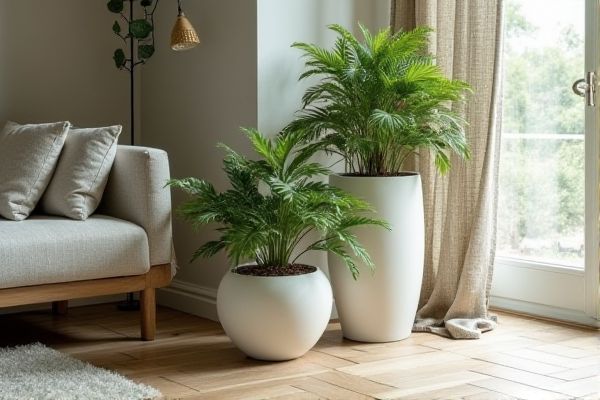
Pedestal planters elevate your plants, offering increased visibility and elegance, while wall planters save space by attaching directly to vertical surfaces, making them ideal for small areas. Explore the rest of the article to discover which option best suits your gardening needs and aesthetic preferences.
Table of Comparison
| Feature | Pedestal Planter | Wall Planter |
|---|---|---|
| Placement | Freestanding on ground or patio | Mounted on walls or fences |
| Space Efficiency | Requires floor space | Utilizes vertical wall space |
| Plant Types | Suitable for large and tall plants | Ideal for small plants and flowers |
| Mobility | Easily movable | Fixed in place |
| Installation | No installation needed | Requires mounting hardware |
| Drainage | Built-in or customizable drainage holes | Depends on design; often limited drainage |
| Decor Style | Classic and formal look | Modern and space-saving design |
| Maintenance | Accessible for watering and pruning | May need ladder or reach tools |
Introduction to Pedestal and Wall Planters
Pedestal planters elevate plants on a sturdy base, making them ideal for showcasing large or decorative plants while adding height to your garden design. Wall planters save space by attaching directly to vertical surfaces, perfect for small patios or creating living walls with minimal footprint. Choosing between pedestal and wall planters depends on your available space and desired aesthetic impact for Your outdoor or indoor garden.
Key Differences Between Pedestal and Wall Planters
Pedestal planters are freestanding containers elevated on a column or base, offering 360-degree visibility and easy access for watering and maintenance, making them ideal for garden centers or patio focal points. Wall planters attach directly to vertical surfaces, saving floor space and creating vertical gardens, which is perfect for small areas or enhancing outdoor walls and balconies. Your choice depends on space availability, aesthetic preference, and functional needs, with pedestal planters providing portability and prominence while wall planters maximize limited area through vertical gardening.
Design Features of Pedestal Planters
Pedestal planters feature elevated bases that enhance plant visibility and create a focal point in gardens or patios, often made from materials like ceramic, stone, or metal to complement various decor styles. Their raised design promotes better air circulation and root development, while offering protection from pests and ground moisture. Unlike wall planters, pedestal planters provide mobility and versatility, allowing easy repositioning to suit changing landscape aesthetics.
Unique Qualities of Wall Planters
Wall planters optimize vertical space by securely mounting to surfaces, making them ideal for small or urban gardens where floor space is limited. Their unique design allows for creative displays of cascading plants or succulents, enhancing aesthetic appeal while improving air quality indoors and outdoors. Unlike pedestal planters, wall planters can double as living art installations, combining functionality with visual innovation in any environment.
Space Optimization: Pedestal vs Wall Planters
Pedestal planters optimize space by providing a raised, standalone platform ideal for small patios or garden corners, allowing you to easily move and rearrange plants. Wall planters maximize vertical space by attaching directly to walls, perfect for limited floor areas or creating green walls that save ground space. Your choice depends on how much horizontal versus vertical space you have and whether you prefer portable or fixed planting solutions.
Aesthetic Impact and Visual Appeal
Pedestal planters create a striking focal point with their elevated design, adding height and elegance that draws the eye upward, perfect for showcasing statement plants. Wall planters save space while offering a modern and artistic display, transforming plain walls into vibrant living artworks that enhance your outdoor or indoor decor. Your choice between the two depends on whether you prefer a bold, standalone aesthetic or a subtle, integrated visual appeal.
Installation and Maintenance Requirements
Pedestal planters require a stable, flat surface for installation and are generally easy to move, making them ideal for flexible garden layouts. Wall planters need secure mounting on a sturdy wall or fence, often involving drilling and anchors, which demands more precise installation skills. You must regularly check wall planter mounts for stability, while pedestal planters require occasional cleaning and repositioning to prevent damage or instability.
Best Plant Types for Pedestal and Wall Planters
Pedestal planters are ideal for showcasing tall, statement plants like fiddle leaf figs, snake plants, and spider plants that benefit from elevated display and better air circulation. Wall planters suit trailing or compact plants such as pothos, succulents, and herbs, which thrive in vertical spaces with good drainage and sunlight exposure. Selecting plant types based on a planter's structure enhances growth conditions and aesthetic appeal.
Cost Comparison and Budget Considerations
Pedestal planters generally cost more upfront due to their sturdy construction and decorative design, making them a higher investment compared to wall planters, which are often more affordable and space-efficient. Budget-conscious buyers should consider installation expenses as wall planters may require mounting hardware and professional installation, whereas pedestal planters are typically freestanding and easier to place. Long-term maintenance costs also vary; pedestal planters may need more frequent cleaning and protection from weather exposure, while wall planters can offer easier access for watering and upkeep, potentially reducing labor costs.
Which Planter is Right for Your Space?
Pedestal planters elevate plants, creating focal points ideal for open spaces or entryways, while wall planters maximize vertical surfaces, perfect for small or urban areas with limited floor space. Choosing the right planter depends on available space, desired visual impact, and plant type compatibility; pedestal planters allow for larger, heavy plants whereas wall planters suit trailing or compact greenery. Assessing sunlight exposure and accessibility also guides whether a pedestal or wall planter better supports plant health and aesthetic goals.
 homyna.com
homyna.com